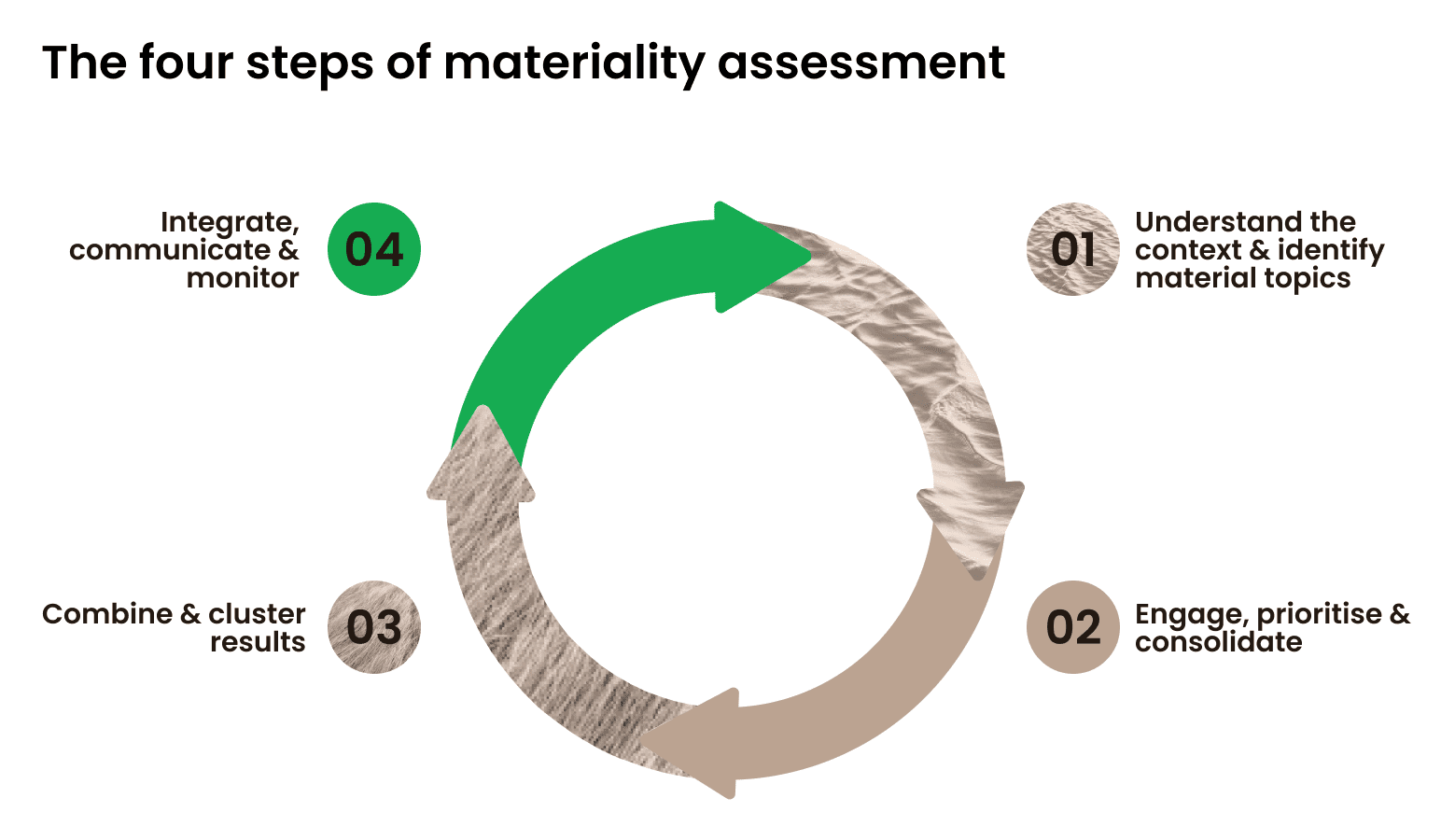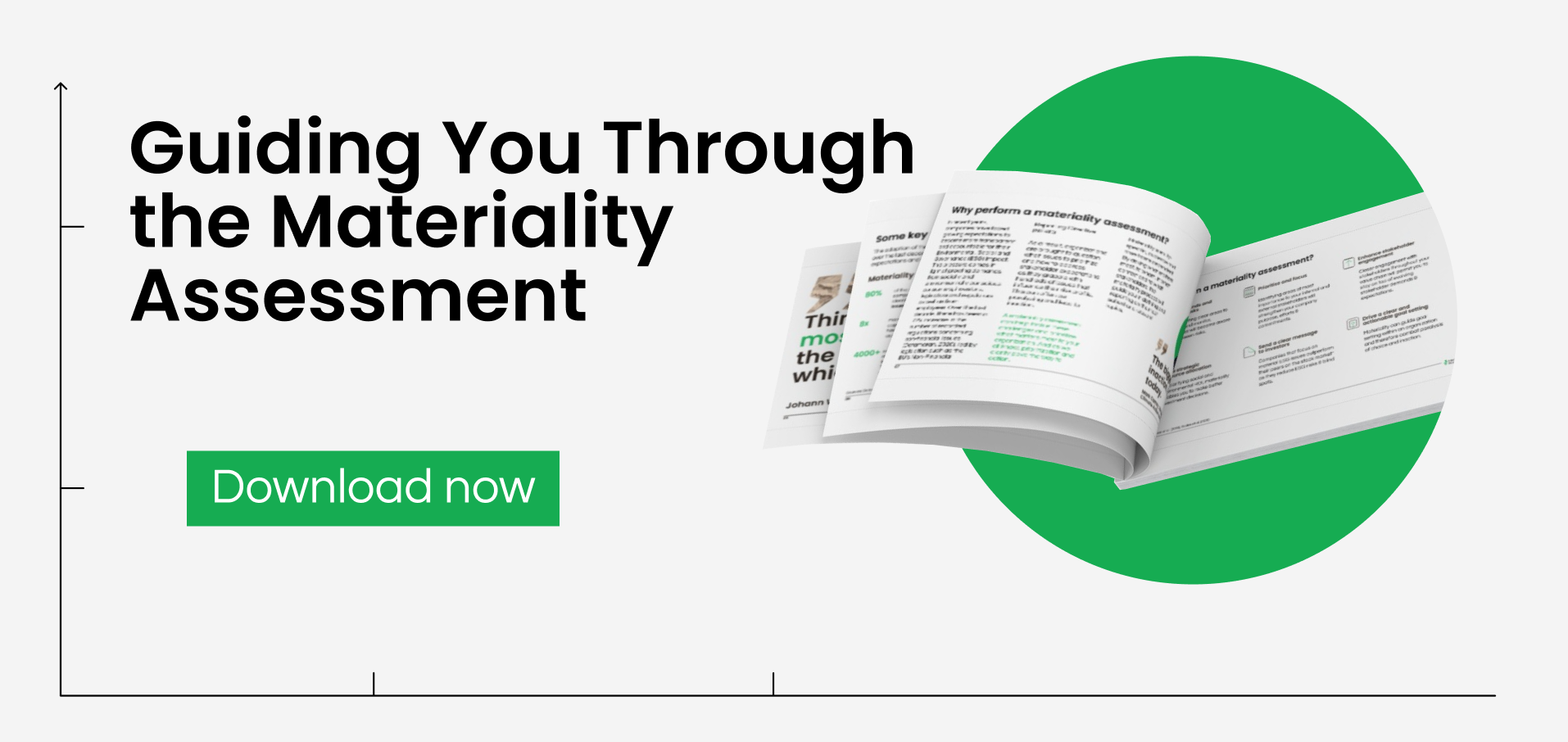4 Steps To Conduct A Materiality Assessment

What is a materiality assessment?
In 1867, the English Court introduced the term ‘Materiality’ in a case, defining it as ‘relevant, not negligible fact’. Ever since the concept has been evolving. In 2006, GRI G3 Guidelines introduced the concept of materiality into the corporate sustainability reporting context.
Today, it has two main areas of focus: a financial materiality perspective and a non-financial materiality perspective. Completion of the assessment is a strategic sustainability tool. It is double materiality as it considers what investors care about but also all other stakeholders. This relates to both social and environmental impact.
The adoption of the materiality assessment process as a guide to sustainability reporting and strategy has consequently increased over the years. About 80% of the world’s largest companies are identifying material sustainability issues in their reporting. Expectations and reporting standards are growing fast. There are now twenty times more non-financial disclosure requirements than there were five years ago.
This article offers you a broad approach to conducting a materiality assessment. If you wish to learn more on the subject, you can download our eBook, Guiding You Through the Materiality Assessment
Why perform a materiality assessment?
Transparency has been a driving concern. Businesses increasingly need to meet expectations from socially and environmentally conscious consumers, investors, employees, regulators, etc.
A materiality assessment or analysis is the opportunity to evaluate the environmental, social and governance (ESG) impact of your organisation. As well as broader emerging challenges that are critical to the success of a business.
The materiality process guides companies to:
- prioritize the identified issues;
- Mitigate risks;
- Drive resource allocation;
- Set goals.
To give just a few benefits.
It is also a chance to engage stakeholders, focus on sustainable development and apply an added perspective to business risk.
A materiality assessment answers the following questions:
- Who are my most important stakeholders (in terms of scope and impact)?
- What are my areas of material focus?
- Where should we focus our efforts and resources?
How to perform a materiality assessment?

Step 1: Understand the context and identify material topics
First, you will have to define the purpose, scope, and approach the company wishes to set. The reporting framework will have an impact. You will be able to conduct some research leading to a long list of material issues. Usually based on relevance to your industry, location, and/or organization.
Then, you will map the upstream and downstream stakeholders making sure to diversify to ensure a comprehensive perspective.
Step 2: Engage, prioritize and consolidate
At that stage, you want stakeholders to engage. The goal is to get to a shortlist of what is the most relevant to your business operations. You will need to draft an engagement plan. Each group will likely prefer or require a different type of engagement.
Workshops, focus groups, interviews, or questionnaires are some of the ways you can approach each stakeholder. This applies to both internal and external stakeholders. We recommend using existing networks or processes for better engagement. Subsequently, you will rank the shorter list in line with the most urgent points.
Step 3: Combine and cluster results
After involving the relevant stakeholder groups, it's time to narrow down your list further. Let’s take a step back to the big picture and incorporate all your results around your long-term strategy. By doing so, you can identify material topics and strategic pillars and elaborate concrete actions from the analysis.
Step 4: Integrate, communicate and monitor
The final step will be to visualize your material issues and communicate them. First, map your results from step 3 on an X-Y axis. That will help to define priorities, taking into account the risk they represent. Then, it is time to exchange internally and integrate your findings into your sustainability strategy with actionable goals.
A communication plan for stakeholders should also be considered. It allows them to advocate the topics and include the most pressing ones in the decision-making process.
Challenges of materiality
Conducting a materiality assessment can be challenging. Clients often face difficulties:
- Finding the right way to prioritise topics;
- Defining boundaries;
- Engaging stakeholders;
- Gathering the data.
How to prioritise topics
Some organizations find it daunting to narrow down the list of topics and indicators to include in their materiality assessment.
A common (and honest) mistake is to create a long list of topics that grows each year. New topics can constantly emerge as significant risks to the company. This makes it hard to focus, set targets and communicate your organization’s impacts and priorities.
Use the materiality process to prioritise. Condense and simplify your risks and opportunities. And don’t end up with more than a dozen topics. Create a ‘consideration threshold’. Map scale against the likelihood of impact per topic. That way you can to narrow it down.
Make sure to cluster topics around clear strategic pillars.
How to define boundaries
Many clients struggle with defining how far their responsibility ‘boundary’ extends. Are companies responsible for upstream suppliers and the behaviour of downstream consumers? This is a concept that has been clarified when talking about emission scopes. However, it sometimes remains blurry when talking about social and human rights issues.
Identify your largest impact hotspots and ensure the scope of your materiality assessment reflects the real ESG impact of your business. Mapping your value chain and related impacts can be a useful exercise.
Is this your first materiality assessment? Then it could be easier to prioritise your group-level approach. You can adapt it to business-unit or geography level at a later stage.
How to engage stakeholders
The list of stakeholders can be very long and complex. Here is a list for you to consider:
- Business leaders;
- Employees;
- Industry organizations;
- Investors;
- Regulators;
- NGOs;
- Consumers.
Making sure to include everyone can seem like a huge task and even risky sometimes.
Don’t reinvent the wheel and use your existing networks. Channels such as customer satisfaction and employee engagement surveys can be a good starting point. Company intranets, groups, committees, etc. can become very useful in gathering insightful data about material topics for different stakeholders.


